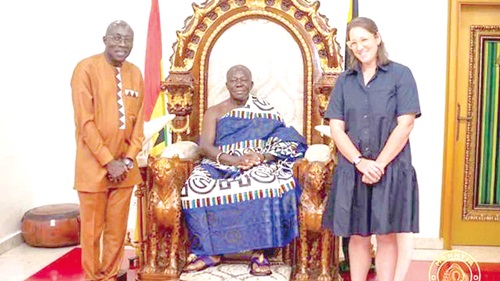
Return of Asanteman’s treasured artifacts... - Prof. Ampene’s call to duty
On February 8, the Ashanti Kingdom led by its king, Otumfuo Osei Tutu II, celebrated the return of some of its antiquities stolen by the British during the 19th-century Anglo-Asante wars.
Advertisement
The seven looted objects included gold decorations for the ankles, arms, and neck, a gold-embellished elephant tail whisk and a chair made of wood and leather with metallic decorations.
Playing a significant role in getting this done was a Professor of Music, Kwasi Ampene, who chairs the music department in the School of Arts and Sciences at Tufts and currently teaches a course on the musical arts of Africa.
The process
Two years ago, Prof. Ampene received an out-of-the-blue e-mail from the curator of African art at UCLA’s Fowler Museum. A renowned expert on the music and culture of the Asante kingdom agreed to help the museum and was instrumental in the processes that eventually led to the return of the antiquities.
Years of research and his Ghanaian heritage had given Ampene a deep understanding of the importance of such objects in what he terms the “history, heart and soul” of the Asante.
Nevertheless, he approached with care. “Given the historical dimension and emotions surrounding violence and pillage associated with European colonization in Africa, I was initially cautious and measured in my response,” says Ampene. “I told myself, ‘This could be something or it could be nothing.”
His review of documents and in-person examination of the items at the Fowler Museum convinced Ampene that this was indeed something. The objects were exquisitely crafted, likely by royal artisans, and their history was well-documented. Others were among the 50,000 ounces of gold demanded by the British government in the treaty ending the wars.
The Fowler Museum and UCLA were fully committed to returning all the precious artefacts to the kingdom, no strings attached. Ampene agreed to assist. To begin the complex repatriation process in June 2023, he met with Otumfuo at the Manhyia Palace and shortly thereafter, he arranged a meeting at the palace for Fowler Museum representatives.
Years before, Ampene had forged a relationship with the king and his staff when he was researching the work of Nana Afua Abasa, a singer and composer of Nnwonkoro songs, who frequently performed at the palace before she died in 2000.
Confirmation
Otumfuo Osei Tutu II confirmed Ampene’s conclusions regarding the artefacts’ authenticity and history. He also said their timely return would be ideal since it would coincide with an event already planned for February 2024 to commemorate the battle in which the palace was demolished.
The Opportunity for a ‘Museum in Motion’
It was a tight time frame to complete the complexities of deaccession and repatriation of the artefacts, a process that would eventually involve U.S. and Ghanaian government agencies as well as the kingdom, museum, UCLA and the university’s Board of Regents.
Ultimately, one of the biggest challenges was obtaining clearance to export the elephant tail whisk because of the strict restrictions on trade in elephant objects. “That took forever,” says Ampene.
Delivered
Permission came through just a couple of days before the artefacts, packed in special protective cases, were to be flown from Los Angeles to Accra. “ This was very, very, very, very nerve-wracking”, Ampene recalls.
Packed in special protective crates, the artefacts arrived safely in Accra on February 1. They were kept in a secret location for several days before making the 156-mile drive to Kumasi under the protection of armed security.
On Monday, February 5, at a private meeting in the palace, the cases were opened and the artefacts were presented to the king and his staff. “The mood was one of joy and mutual respect,” Ampene recalls.
At the meeting’s conclusion, Ampene felt a huge wave of relief. “I hadn’t slept that whole weekend,” he says. “The first thing I did afterwards was drink a glass of wine.”
Triumphant return
Having been received with such celebration by Asanteman, the artefacts returned by the Fowler Museum will be displayed at the Manhyia Palace Museum. However, Ampene believes that museums should not be a prerequisite for repatriation of stolen antiquities.
“These items are part of our culture and our identity. They have practical uses for us, they have spiritual uses, and they reinforce our traditional political systems, our philosophy, and our literature. We know what to do with them,” he says. “They don’t need to be in a museum. When we bring them out at a festival, that’s our museum in motion.”
Loan not ideal
The artefacts’ return played out against an intense and widening global conversation about the return of treasures stolen by colonising powers. Just a few weeks earlier, London’s Victoria & Albert Museum and the British Museum had said they would “loan” back to the Asante kingdom, some artefacts stolen during colonisation. That approach is abhorrent to Ampene.
“We must not reward theft,” he says. “In contrast, UCLA showed the whole world what can and should be done. We now have a model to do it the right way.”
The author is the Executive Director of Public Relations at Tufts University, USA




